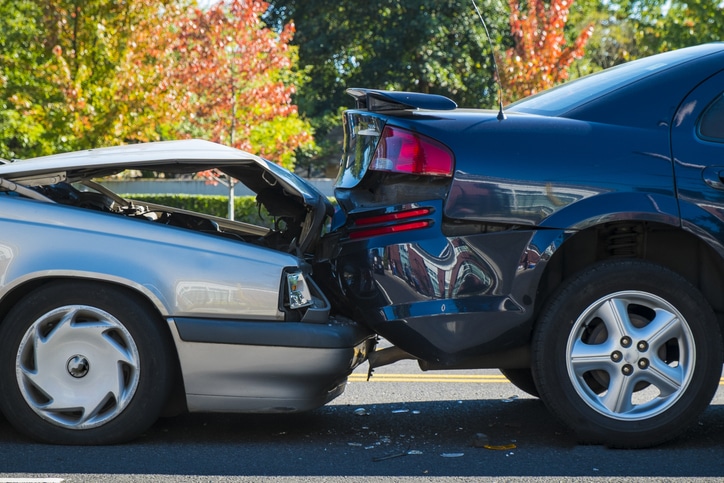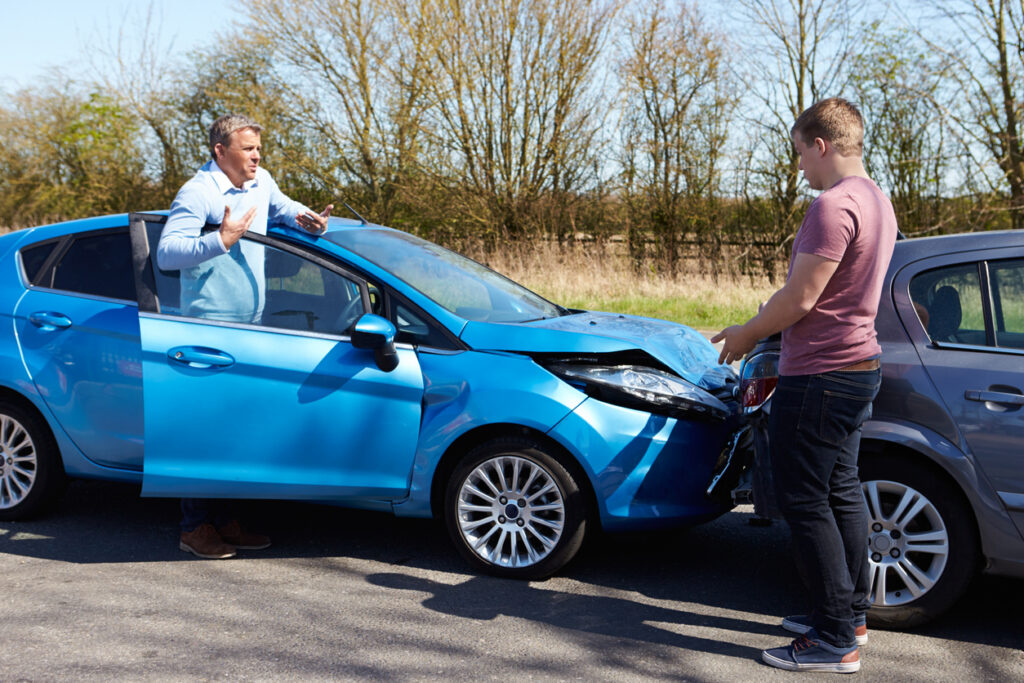Rear-End Collisions in California
August 2, 2024 | Article by Chain | Cohn | Clark staff Social Share

A rear-end collision is a vehicle accident in which the front of one car comes into contact with the back of another car. These types of crashes are usually “fender benders,” a term that refers to minor accidents. Even though the chances of car damage and severe injury are lower, they can still occur. And even if they don’t, a rear-end collision can still cause inconvenient injuries and expensive repairs, even at low speeds.
If you suffered a neck injury or other serious consequences following a rear-end collision in Bakersfield that was not your fault, contact the car accident lawyers at Chain | Cohn | Clark to schedule a free case evaluation. Call 661-616-9829 to find out how we can help.
Why Are Rear-End Collisions Common?
Drivers in the same lane are front bumper to back bumper significantly more often than any other interaction between vehicles. During traffic jams, everybody is very close to one another and even a moment of distraction can result in a small rear-end crash.
People sometimes have to make quick stops when lights turn, or when they don’t see a stop sign until they are relatively close. If the driver behind them doesn’t have enough stopping distance, they may not be able to avoid an accident. Certain weather conditions and car malfunctions can also make it difficult to avoid rear-end collisions.
Although rear-end accidents are some of the most common car crashes, they are not always as extreme as head-on or side-impact collisions. Both cars are either traveling the same direction or one is moving and the other is stopped; this situation reduces the overall velocity of the crash. There’s a lot of car between the driver of a trailing car and the driver of a leading car, which helps prevent serious injury.
That being said, rear-end collisions have the potential to be severe—or even fatal—depending on how fast the trailing driver is going. Driving speeds and behaviors also factor into determining who is liable for paying damages.
Determining Fault in a Rear-End Collision
Rear-end accidents occur when one motorist drives into the back of another vehicle. When determining rear-end collision fault, the trailing driver is generally held responsible for the resulting damages. Drivers have an expectation to leave enough room that they can stop with appropriate time and safely share the road with another vehicle.
If the lead driver is driving normally and the trailing driver hits them for one reason or another, it is the fault of the driver in the back. There are some situations in which the trailing driver will not have to pay for injuries of the leading driver.
First, let’s discuss when an accident is caused by the leading driver. Although rare, there are situations in which the driver in front can be the primary cause of a rear-end accident. Examples include if they are driving without working brake lights at night, if they are not using proper signals and slow to turn, etc. If you are injured because of a negligent leading driver, you may have a case for compensation.
The other situation pertains to contributory and comparative negligence. There are fault laws in California that can prevent the leading driver from receiving benefits if they were at least 50% at fault. If they were any percent less responsible, the overall settlement value would still be reduced. This happens when the trailing driver is primarily responsible but the lead driver contributes in some way, such as brake checking somebody who is tailgating.
When a rear-end collision is not your fault, you should hire a Bakersfield car accident lawyer from Chain | Cohn | Clark to help you recover the proper damages. We can help you prove that the other driver was negligent and outline the full compensation you might need.
California Rear-End Law
There is actually a portion of the California Vehicle Code (CVC) that relates directly to rear-end accidents. Part 21703 VC forbids drivers from following other vehicles at an unreasonable distance. While there are no specific rules detailing how close drivers can be, it does mention that factors like weather conditions, traffic, and speed should be taken into consideration.
Punishments for following too closely, also commonly referred to as tailgating, include a $238 fine and a point on your California Department of Motor Vehicle driver’s record. Points on your driver’s license lead to an increase on your insurance and a suspended license if accumulated.
In addition to discouraging tailgating, CVC Section 21703 can also help the victim of a rear-end accident recover compensation in a civil case. If a driver receives a 21703 violation after a rear-end accident, the driver who was in front can use that ticket as evidence to establish negligence.
Other California State Laws That Affect Rear-End Collisions
On top of CVC 21703, there are two more laws that sometimes make an appearance in rear-end collision cases.
CVC 22100.5 prohibits U-turns at intersections unless specifically allowed by the law. When a U-turn is plausible, the driver must yield to all other drivers in the oncoming lane. If a driver performs a U-turn without giving themselves enough time to get up to speed, they may be held liable if they are hit from behind by another driver.
CVC 22350 outlaws speeding on the highway. Beyond the speed limit, this section forbids drivers from going any speed that is unreasonable with regards to the traffic, visibility, weather, and highway conditions. This can be a factor if the driver in the back goes too fast and hits the driver in front of them or if the driver in front slows down to an unreasonable speed for no reason and causes the following driver to crash (see brake-checking in the next section).
Rear-End Collision Causes
A number of different factors can lead to a rear-end accident. Here are some of the more common causes that we see in California.
Distracted Driving
The most common cause of rear-end collisions––especially minor fender benders––is distracted driving. Drivers who are in bumper-to-bumper traffic and look down at their phone for a second too long because they feel safe can easily cause a crash. Listening to music too loudly or looking away from the road and not noticing the leading car slowing down are also examples of rear-end collision causes.
Animal Crossing
One reason a lead driver might unexpectedly slam on their breaks is to avoid hitting an animal or other road obstacle. If the object was somewhere it shouldn’t have been or came out of nowhere, it can be hard to determine who was at fault for the accident. Reach out to a lawyer if you have questions or would like to pursue damages.
Vehicle Malfunctions
A rear-ending accident can occur due to mechanical errors in either the trailing or leading vehicle. If the brakes or tires in a trailing vehicle are not properly maintained, a driver might not be able to stop in time to avoid an accident. If the leading driver does not have working tail or brake lights, they might be held accountable for any injuries that occur.
Driving Under the Influence
Drugs and alcohol can both severely impact someone’s ability to operate a motor vehicle. In many accidents, it can be difficult to determine who was at fault. If one of the drivers was under the influence of an illegal substance, they will likely receive a majority––if not all––of the blame.
Brake Checking
One cause of a rear-end collision could be a form of road rage called “brake-checking.” This action involves a driver intentionally slamming on the brakes to annoy, intimidate, scare, or surprise the driver behind them. Drivers might do this when they are being tailgated or because they are irritated with the driver behind them.
Brake checking is risky and does not accomplish anything. Furthermore, the individual who slams their brakes might be held partially––or fully––liable for the accident.
Rear-End Collision Injuries
Although many rear-end collisions are mild fender benders, there are still plenty of serious injuries that result from more severe crashes. Sometimes people will sustain injuries that last for years after the accident.
Whiplash
One of the most common injuries for drivers who get rear-ended is whiplash. This is the term used to describe damage to soft tissue in the neck. Car crashes cause the head to move violently and strain the neck. When ligaments or tendons are sprained and torn, the victim can have lasting pain, stiffness, and limited mobility. Mild whiplash may only require some time off work and/or physical therapy.
Back Injuries
The back is involved in almost every movement we make. If something happens in a car crash that leads to damage in the upper or lower back, it may cause serious problems for the victim. They may not be able to work for extended periods of time. If surgery is necessary, it can be expensive and cause financial stress on the victim. If you sustain a back injury in a rear-end collision, you may be able to retrieve compensation.
Brain Injuries
Damage to the brain can result in long-term behavioral and physical effects. When a car is hit from behind, the body is often jerked or jolted in an abrasive way. The head may come into contact with the steering wheel, a window, or another solid object. This impact can cause internal bleeding, concussions, or even traumatic brain injuries (TBIs).
Broken Bones
Depending on the severity of the crash, you could break almost any bone in your body upon impact. If your legs or arms absorb the majority of the shock, you may experience damage to the external limbs. If you sustain damage to more essential bones, you may end up needing treatment for a much longer period of time. This recovery can be expensive and require multiple surgeries.
Spine Injuries
The spinal cord is home to a plethora of nerves that control the body, so damage to the spinal cord can lead to partial or complete paralysis. If the rear-ending accident leads to the victim being paralyzed, they may have a significant case for compensation.
Contact Chain | Cohn | Clark After Your Rear-End Collision
If you are suffering from injuries or a debilitating fear of driving after a car accident, reach out to our team of experienced car accident attorneys at Chain | Cohn | Clark for legal assistance.
You can fill out the contact form on our website or call us at (661) 616-9829 for a free consultation today.

